Hi! Who are you, and what are you currently working on?
I am Dominick Gatto and I’m a professional wildlife photographer from New York.
Over the last year I’ve developed a plan to turn my photography into a business, ranging from wall art sales, commercial licensing, and even selling digital products to aid fellow photographers in the field.
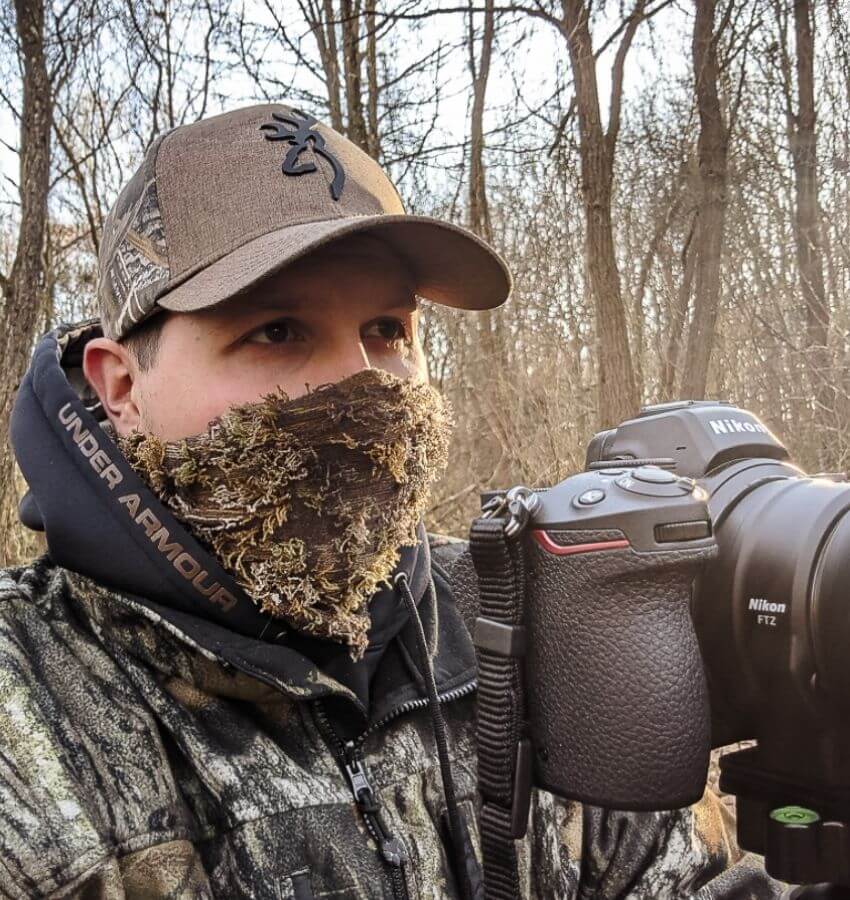
I never imagined that my passion for the outdoors would develop into a consistent form of revenue, however I dove in head-first when I realized there was a demand for what I had to offer.
My goal is to eventually be a full-time wildlife photographer traveling North America in pursuit of big game.
I’ve begun the process of building a library of photographs to cater to both private clients as well as commercial establishments and publications, which will aid me for years to come in this venture.
Although it may seem insignificant, my most regarded achievement during this journey was making my first sale.
A gentleman reached out to me before I had even considered selling my work and asked about ordering prints. Not knowing how to go about this process, I said “Of course! What do you need?”.
Hours of research into printing as well as phone calls with other notable photographers ensued, and by the end of the day I had the photograph the client wanted ready to go. That’s when it clicked: this isn’t just a passion, it’s a profession.
What’s your background, and what motivated you to start your business venture?
I’ve been hunting since I was a child. Walking in the woods with my father in the fall, scouting trails in the summer, and generally being in the outdoors made me feel at home.
I didn’t pick up a camera until I was in high school, which was a Nikon D40. I immediately knew it’s what I wanted to do. I would go on hikes with my basic camera setup – no fancy lenses or equipment, and try to create scenes.
Later in life, I attended Seton Hall University and studied marketing, using that knowledge for the following 10 years to become a photographer locally.
I would do portraits, small sessions, events, the usual suspects for a side-job photographer. It made some decent pocket change, and I enjoyed it.
When COVID hit last year, photography clients dried up due to all of the restrictions. I was already working a day job, so I wasn’t in too much financial trouble due to it, however I had a new commodity to spend: time.
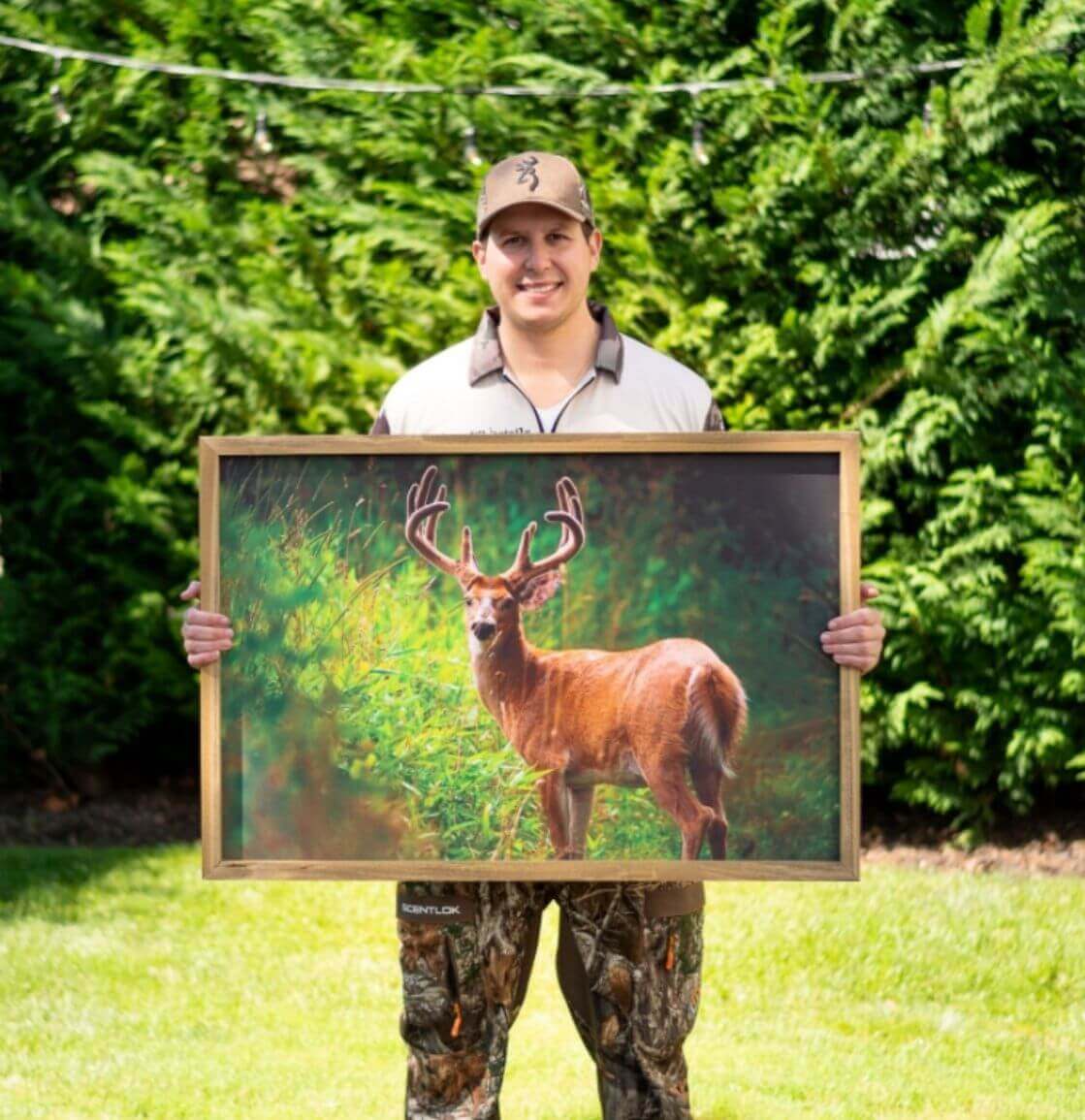
I decided one day to bring my camera out with me, a Nikon D3500, with an AF-P 70-300mm lens, into the woods. After a few days of doing some normal scouting, as I would when hunting, I came across a few deer.
I didn’t treat this as business at first. I started posting photographs to social media and gained a small following. Each and every time I went out to the woods I would try to do better, and over the course of several months it began to gain traction.
How did you get started? What did the early days look like?
What made me start thinking of this as a business was the untapped demand. Most of the photographs of wildlife, specifically whitetail deer, that I had seen were all similar: a deer in the field or the woods.
Sure, there were some exceptional photographers who captured once-in-a-lifetime moments, but those were the big players. So what was I to do as a no-name photographer in a sea of no-name photographers?
I made it unique. I started focusing on editing my photographs to be different and eye-catching. Each and every time I wanted my work to appear as if it was something nobody else in the world could create, and thus I developed a particular style.
I went in completely blind with this process, not knowing if people would respond to it in turn. However, within 8 months I had grown a following on Instagram in the 10,000 range.
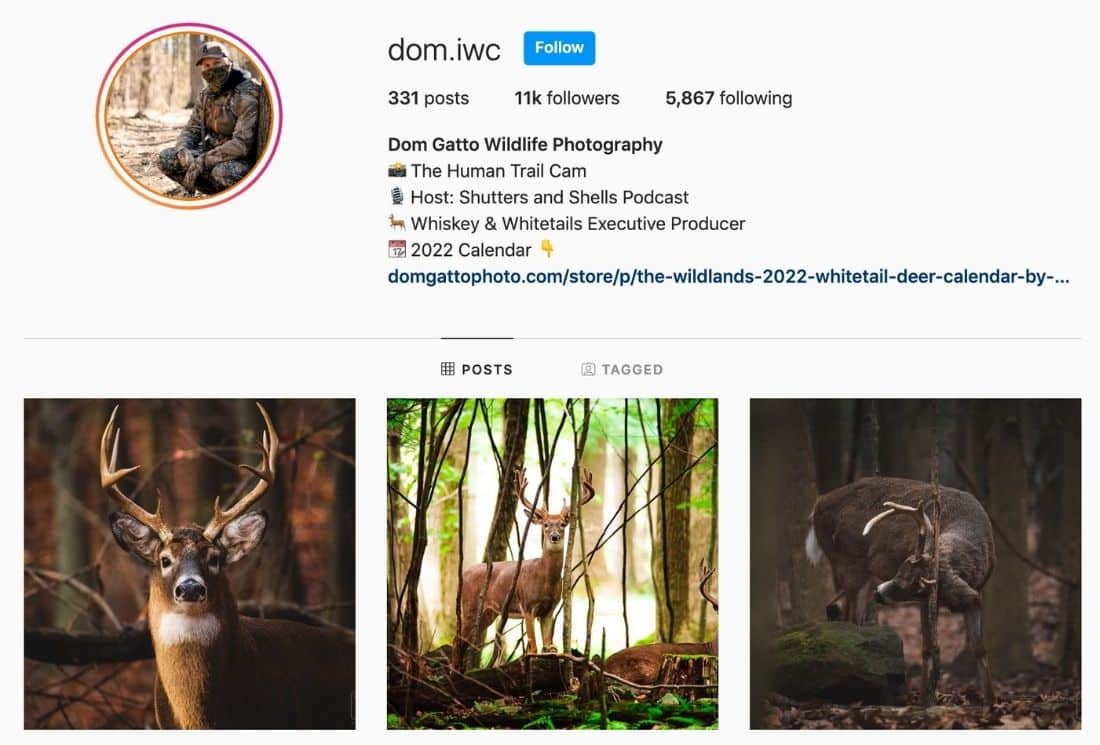
That kind of growth triggered opportunity. I was contacted by individuals and businesses to be part of their projects.
I was a guest on podcasts. I was offered compensation for instructing beginners on the basics of wildlife photography. At the time, and still today, I don’t see myself as an expert on the subject.
However, I keep that mentality due to the fact that there is ALWAYS more to learn. I had a lot of guidance in the beginning from photographers who were much more involved in this world than I was, and I’m happy to pass on the knowledge.
How have you grown your business venture?
The business side of things grew very, very slowly at first. I had not started this venture to make money off of it, I started it because I enjoyed it.
I think the fact that I was passionate about what I was doing and not in it for the money resonated with people, because I started receiving messages daily from individuals seeking to purchase my work,
At that point, I went into marketing mode. I started thinking about who my target audience was. I mainly photographed whitetail deer, so I started catering more to the hunting crowd.
I would reach out to larger pages on social media and start connecting with them.
My photographs started getting shared regularly across various platforms, and even featured by big names such as Mossy Oak and OnX.
The most important thing I learned along the way is how social media actually works. Most people think they can just post a photograph and people will come flocking.
That’s wrong, at least at first. You need to spend time each and every day interacting with people who are in your target market. Make it about them, not about you.
What is 1 small but powerful tactic you implemented that helped you achieve success? How did it make a difference?
Consistency is key. I would post daily, sometimes once every other day, but I never missed a day of interaction.
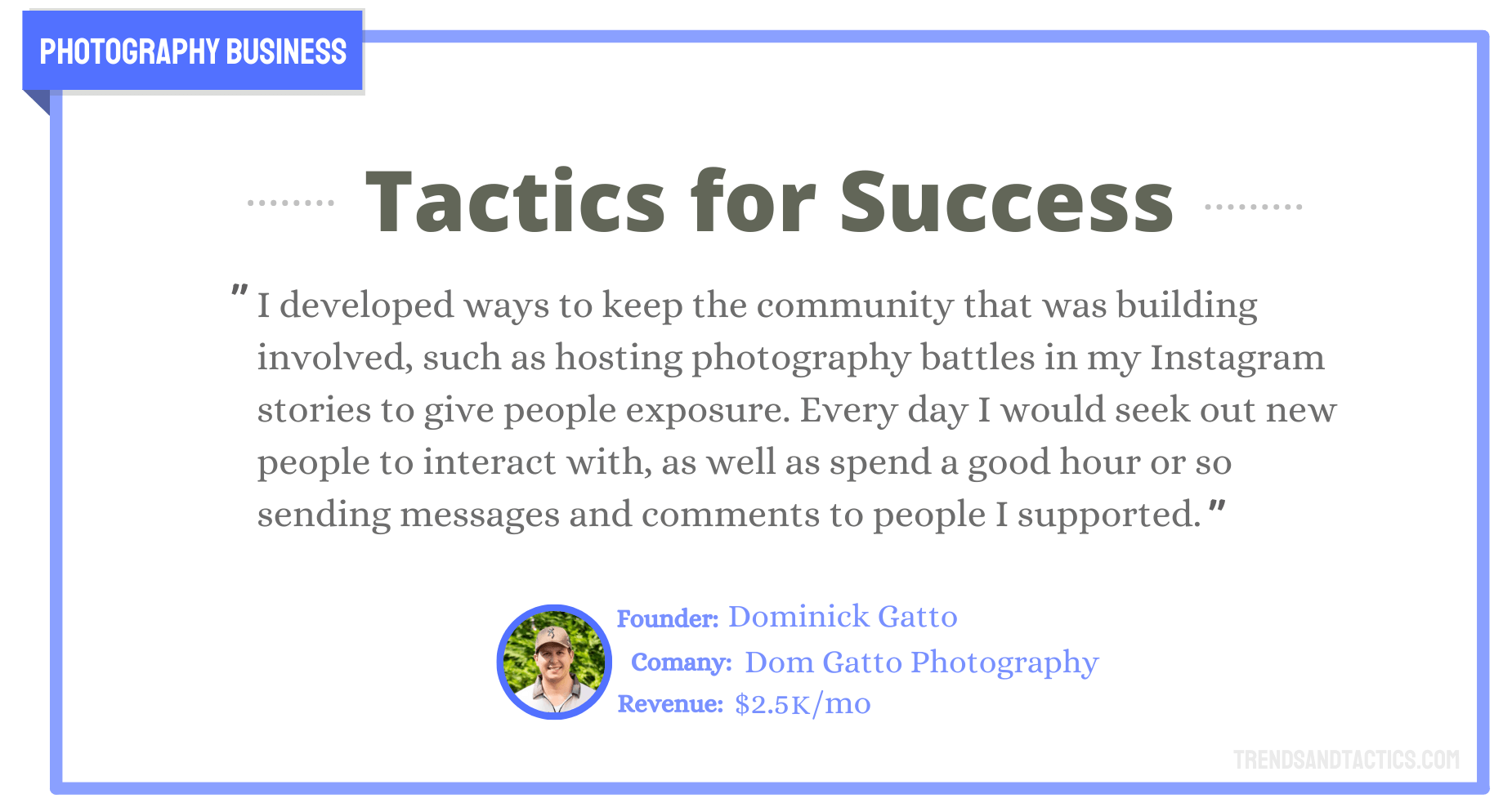
I rode a fine line between enjoyment and work doing this, as it is very time consuming.
A lot of people asked me how I got my social media accounts to grow so quickly, and the answer was a simple truth: consistency and time. You need to put time into social media if you’re growing a business, and you need to do it consistently.
A week isn’t enough, a month isn’t enough, even a year isn’t enough. Every single day is a grind to a larger goal, and if you slip up for a long enough period of time you’re going to fade away.
That being said, if you go too hard with your content you’re either going to run out of things to put out there, or you’re going to burn out.
I developed a plan where I would have a month’s worth of photographs ready to go, that way I didn’t have to spend each and every day worrying about what I was going to post.
Batching your content will keep you sane – spend a few hours each day on the weekend organizing your week and you’ll essentially have the entire week to focus on more important things in your business.
What is 1 of the biggest challenges you faced during your business journey, and how did you overcome it?
The biggest challenge was probably being a photographer in a sea of photographers.
Any photographer who is marketing on a broad scale has to be a cut above – there are so many options in the age of social media to choose from, so what do you do to make your work stand out?
The largest roadblock I hit when I began to make a small amount of sales was finding a reliable product chain.
I started by having prints made by several different print labs and choosing which lab gave the highest quality product. I then shipped dozens of these prints to my home and manually fulfilled orders as they came in.
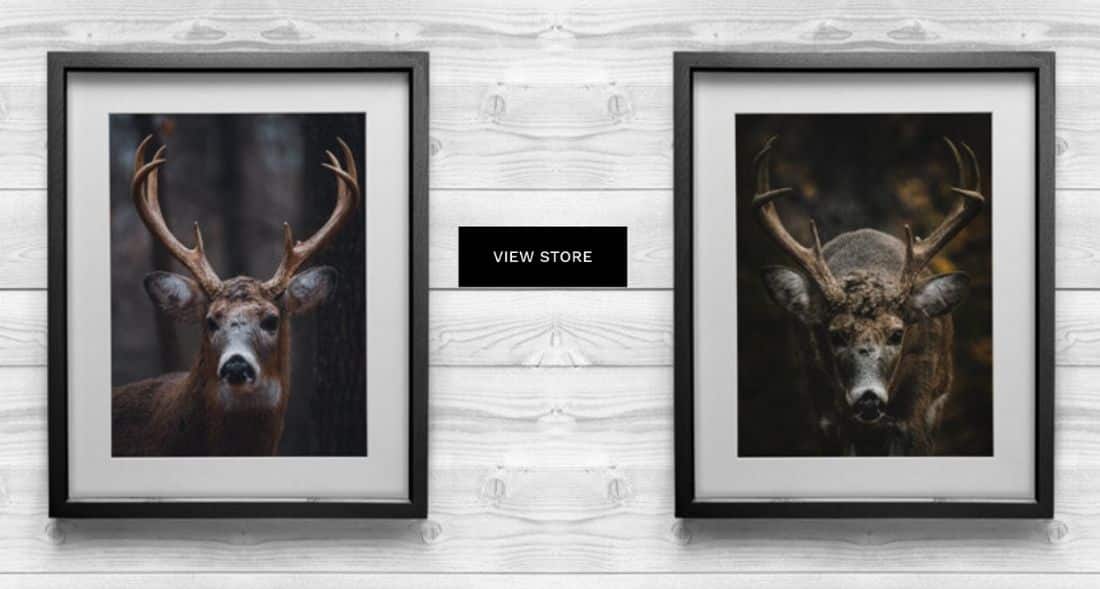
That brought up a new problem: I was carrying inventory with no knowledge of the demand. I began to have stacks of prints that wouldn’t sell for one photograph, while running out of stock for another.
The problem with selling your photography is that you can’t just offer someone a completely different photograph when one isn’t available, they want THAT ONE. So I lost a few customer opportunities due to that.
I finally found another private print lab that had a solution to my problem, which was eventually drop-ship print services.
They would print, pack, and ship for me for a small markup, therefore I could keep my prices the same and not worry about unnecessary expenses.
I ordered one of all of my available prints from them to check the quality of both the actual print as well as the shipping method, and thankfully it was up to par.
With this added flexibility, I was able to invest more time into the creative side of the business and less on the administrative work.
I learned a valuable lesson: time is everything. If I’m spending all of my time packing and sending out orders by hand, I’m spending less time in the woods capturing unique photographs that can potentially sell.
The extra cost to have my process somewhat automated outweighed the time I would spend doing it myself.
What is 1 new or unusual trend showing up in your industry that you’re paying attention to?
I’ve always loved the phrase “steal like an artist”. I keep an eye on what other photographers in my field are doing, and if the idea seems fruitful, I dive right in.
For example, I saw a photographer take some of his best photographs from the previous years and arrange them into a calendar. I thought, “Hey, I can do that!”
Within a week of launching my own calendar featuring my photographs, I made $1,000 in sales. I started to realize that I wasn’t in the business of selling fine art, but in the business of selling my artwork coupled with utility.
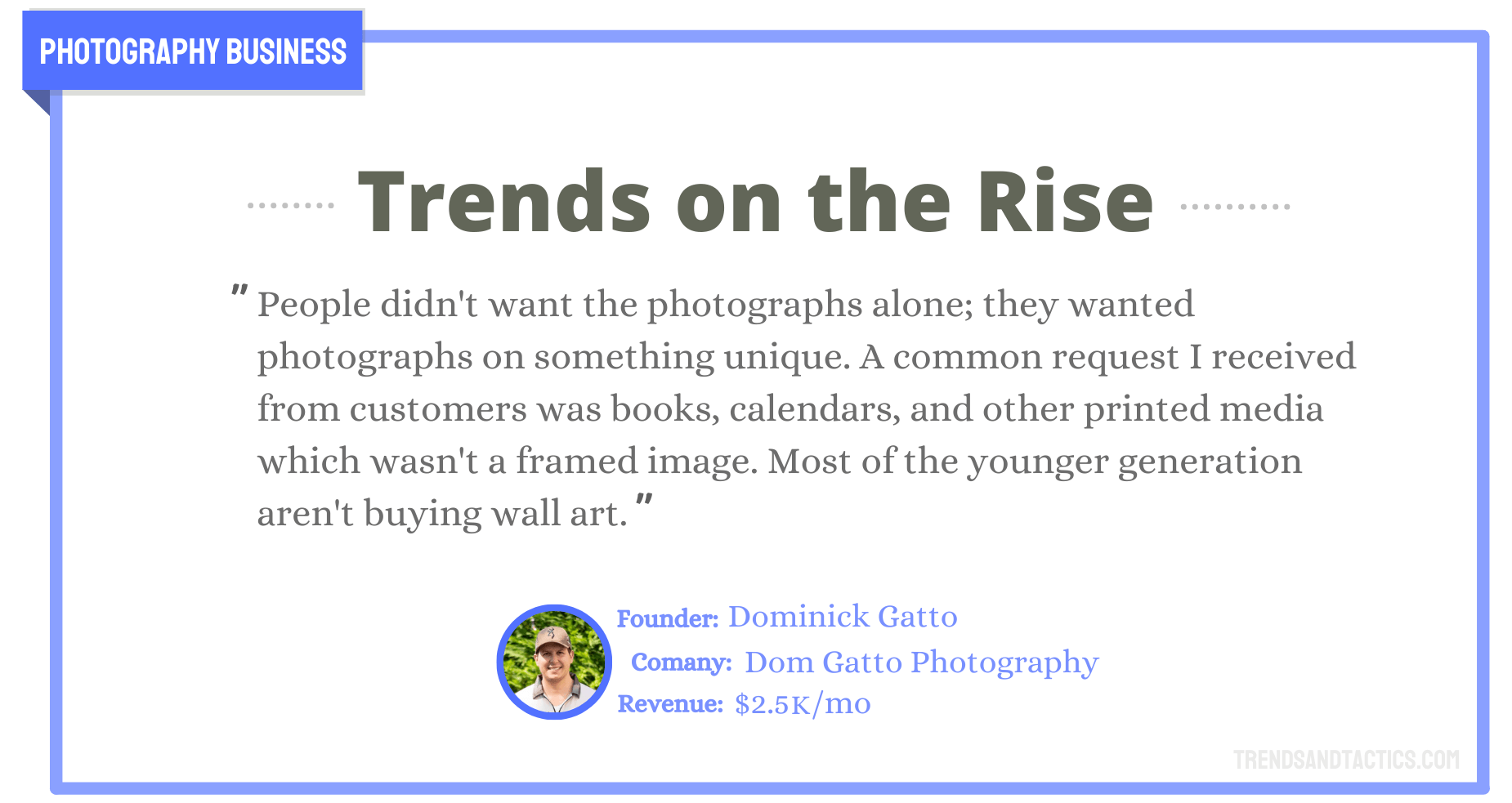
The younger crowd wants physical items that they can show off anywhere rather than a photograph they can stick on the wall and leave there forever.
There’s definitely still a market for prints and home decoration, but there is much more potential to be seen in utilizing photographs on unconventional mediums.
What is the biggest factor that separates successful people from people who fail or never get started?
Time, and by time I mean the time you put in. I know the term “rise and grind” is so overly used in today’s world of pseudo entrepreneur coaching, but the truth is you need to be ready to put in those 100 hour weeks in order to see results in the long term.
Any new business is like a baby – it needs constant attention and nurturing or it will fail.
When I first started out, I would spend hours cold calling and networking to expand my potential reach. There was no “Well, it’s 5 o’clock, time to end the day”, it was a constant push to gain more traction.
The more I put into learning who my audience was, the more I seemed to understand who I was marketing to. Every interaction had a purpose. Every message and voicemail sent was done methodically.
There was an end goal to each conversation. 99 times out of 100 I would not reach that goal, however the 1 time I didn’t each round paid off for all of the failures.
Consistency is also a factor with time. Anyone can commit to doing cold calls and messages for a few days, but it takes real commitment to put in hours of work for only potential pay for months straight.
I think if I gave up at 6 months of pushing those numbers, I would have missed out on 90% of what I’ve accomplished thus far. You always have to look towards the light at the end of the tunnel.
What advice would you give to someone just getting started?
I wish I learned something extremely important when I started out: pace yourself. If you can’t be consistent with showing your work off on social media consistently, you aren’t going to go anywhere.
I would spend weekends organizing a week’s worth of posts for Instagram when I was new to the game, that way I had more time during the week to engage with my community and spend time in the woods.
Being consistent on social media can feel like a job sometimes, but if you’re leveraging a platform for the purposes of monetization, it technically is a job.
I started out posting consistently for about 2 weeks, which I soon discovered to be extremely difficult. I ran out of photographs quickly!
So after a short lull, I then started organizing. I have a library of thousands of photographs, many of which I have never shown anyone, but one day they will make the feed.
Each and every post I make now is thought out days, if not weeks, in advance. Don’t bite off more than you can chew. Write up a plan, then execute it with everything you’ve got.
How are things going today and what’s next?
Everything is going, for lack of a better term, great. I’ve hit milestones in the last year that I didn’t expect to hit for the next 3 years at least.
I landed contracts and retainers with companies who seemed unobtainable at the time. I’ve connected with some of the top dogs in the industry and picked their brains.
I never thought I’d be in the position I am currently in, because just over a year ago I was draining my bank account on gear and overhead costs with no certainty that I would make it back.
Now, I’ve paid all of the bills and turned a significant profit in just over a year. The most exciting update I have is that I released a 2022 Calendar, and I plan on releasing a photo book by the end of the year.
I’ve also been offered paid consultations to lecture photographers on hunting tactics and how they relate to wildlife photography.
I’ve also started a successful podcast where I’ve had hunters, entrepreneurs, CEOs, and professional photographers as guests. It’s all happened very fast, but I’m up for the challenge of growth.
As far as growth goes, there are growing pains. With more orders and more interests comes more administrative time.
At some point I’ll be expanding the business and hiring someone to handle the sales full time, that way I can focus on the content creation.
I’ve also considered hiring a social media manager, but I’m searching for someone who can run my page with the same methods and gusto that has worked for me over the last year.
That plan is at least a year or two away, but we’ll see what that time brings.
I went from 0 to 10,000 Instagram followers in 8 months, I’m currently approaching 10,000 followers on TikTok, and I’ve turned a profit in what I would consider a very short amount of time.
All of my sales have come through word-of-mouth as well as social media outlets with no advertisements, which tells me I must be doing something right!
What have been the most influential podcasts, books, or other resources?
I spent a lot of time and money doing my own research and testing, which included spending thousands on cameras and lenses until I found a setup that worked for me.
I wouldn’t say I did a lot of reading up on traditional methods, however what helped the most was reaching out to other professional photographers that I considered much, much better than me and asking them questions.
This is also the reason I never let a DM go unresponded to – I could not have done this without the insightful help of others, and I want to pass on the favor.
Where can we go to learn more?
You can find me on Instagram at @dom.iwc
My website, store, and portfolio is located at DomGattoPhoto.com
If you want to learn more about hunting and wildlife photography and how the two skills work hand in hand, check out my podcast Shutters and Shells.
Thanks so much, get outdoors!
Jack Brewer is passionate about all things personal finance, and enjoys testing out new side hustles and investing strategies.






